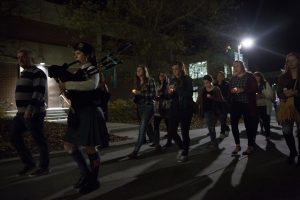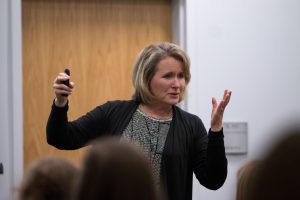
Valerie Hudson said she went to graduate school at a time when students could take an entire curriculum’s worth of classes and never know women exist.
“It was just a complete exclusion of women’s perspectives, women’s concerns, women’s security — none of that was part of that world,” she said.
Hudson is a former BYU professor and currently directs the Women, Peace, and Security Program at Texas A&M University. She’s also the co-author of “Sex and World Peace,” a book exploring how the subjugation of women weakens a nation on every level from security and politics to health, wealth and more.
That weakening can be seen in Utah where one in three Utah women will experience domestic violence in her lifetime, according to the Utah Women and Leadership Project.
Susan Madsen, founder of the Utah Women and Leadership Project, said these kinds of relationships affect friends, extended families and communities, not just the victim and the perpetrator.

“It affects nearly everyone in some kind of way, so we need to think about that,” she said.
Madsen spoke on Oct. 23 at a candlelight vigil for domestic violence awareness, hosted by UVU and organized by the Center for Women and Children in Crisis with the Utah Domestic Violence Coalition.
Lindsey Hulet is a senior at UVU studying social work and attended the vigil. Hulet, who is also an intern with the Center for Women and Children in Crisis, said the vigil was a cool opportunity.
“This is my first time ever doing something like this. I wasn’t really sure how it would go, but I think it went pretty well,” Hulet said.
Madsen presented some of the Utah Women and Leadership Project’s research on domestic violence at the vigil, which was held for the first time last year.
The Utah Women and Leadership Project’s findings include that every year in Utah, more than 40 percent of adult homicides are related to domestic violence; approximately 80 children witness the murder or attempted murder of their mothers; and how divorced and separated women have the highest incidents of reported domestic violence (42.1 percent), higher even than the percentages of both married (11.2 percent) and unmarried women (12.7 percent).
“These are reports,” Madsen added. “So do you think everything is reported? No. … And some experts will say in the state of Utah that maybe we struggle more than even other states with reporting.”
Madsen defined domestic violence as a pattern of behavior involving violence or other kinds of abuse by one person against another in a domestic setting such as marriage. It includes any combination of psychological, sexual or physical abuse, and it’s used to hurt, dominate and control an intimate partner.
She also said there’s an abundance of myths surrounding domestic violence, such as, “It only happens to poor women and women of color,” or, “If it were that bad, she would just leave.”
In addition, there are a number of reasons women don’t report abuse, such as fearing what the perpetrator will do to her and her children, having no resources to leave, or even having a legal history herself which might result in arrest if she asks for help.

Though domestic violence is primarily a crime by men against women, it can occur the other way, and it occurs in both heterosexual and same-sex relationships, Madsen said.
“There’s women and sometimes men that are in those kinds of relationships that don’t realize that they actually fit under the domestic violence (umbrella),” she said.
She also said more Utah men than women commit suicide over domestic violence.
“Men have societal norms that they should be tough and not cry and do different things, and that makes it challenging (to get help),” Madsen said.
Hudson said when young men are socialized to disassociate from their emotions, it creates dangerous definitions of manhood which fuel domestic violence.
“(When) the most powerful way to gain status in a male community is to prey upon women and degrade them … (that is) setting ourselves up for a very violent and unstable society,” she said.
Hudson added young women aren’t taught how to effectively insist on consent in their relationships with men; they’re also often not taught basics about childbirth, breastfeeding or the possibility of pain during first-time sexual intercourse.
“And as a result, I think we send them out as sort of lambs to the slaughter,” she said. “We keep them in stunning ignorance, and then we cry when tragic choices are made.”
Hudson said domestic violence will be less likely to occur when men stop raising each other’s social statuses for preying on women. This means not standing for “locker room talk,” not watching pornography together as a bonding mechanism, and simply not making fun of women.
“Really, there has to be a change with men not giving each other status – in fact, lowering each other’s status if they hurt women,” she said.




